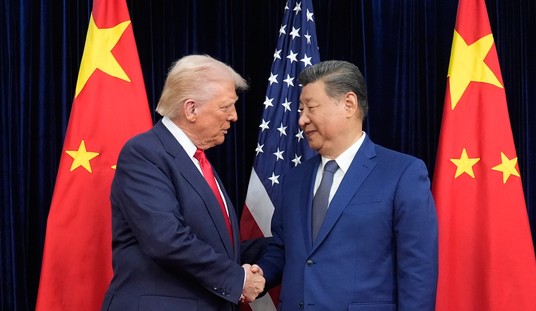The Air Force snubbed longtime partner Boeing and awarded a lucrative contract to Northrop and EADS, the European maker of the Airbus, to build a fleet of refueling aircraft. The decision stunned Boeing and elected officials in the Northwest, who immediately objected to the decision to reject the all-American option. However, officials claim that Boeing’s submission simply didn’t measure up — literally:
Air Force officials offered few details about why they choose the Northrop-EADS team over Boeing since they have yet to debrief the two companies. But Air Force Gen. Arthur Lichte said the larger size was key. “More passengers, more cargo, more fuel to offload,” he said.
“It will be very hard for Boeing to overturn this decision because the Northrop plane seemed markedly superior” in the eyes of the Air Force, said Loren Thompson, a defense industry analyst with Lexington Institute, a policy think tank. And as the winners of the first award, EADS and Northrop are in a strong position to win two follow-on deals to build hundreds of more planes.
Boeing spokesman Jim Condelles said the company won’t make a decision about appealing the award until it is briefed by Air Force officials. Boeing believes it offered the best value and lowest risk, he said.
Stifel, Nicolaus & Co. analyst Troy Lahr said in a research note it was surprising the Northrop-EADS team won given the estimated $35 million per-plane savings offered by Boeing. Lahr estimated the Boeing aircraft would have cost $125 million apiece. “It appears the (Air Force) chose capabilities over cost,” Lahr said.
In short, Boeing gave a better price, but Northrop/EADS gave more capabilities. It can deliver more fuel or carry more personnel and/or cargo, depending on configuration. That may be a rational trade-off, and the Air Force is the organization best positioned to make that choice. They understand what their missions require and should know which airframe best complements them.
Appeals rarely if ever work, as the GAO assumes the client (Air Force) knows what it’s doing. It will only have a chance of succeeding if Boeing can demonstrate that the Northrop/EADS offering does not meet the specifications demanded in the RFP, or if the competing bid has unfair pricing or other violations of the process. And even then — as I know from personal experience — Boeing is unlikely to succeed, and could damage their chances for future contracts.
In the mid-1980s, the FAA put out an RFP for a system to completely replace the air-traffic control system across the nation. Two companies got selected to compete for the prime contractor position, IBM and Hughes Aircraft. The spec had three bedrock requirements: the system had to use all-new components in the ATC suite, it had to be functional at the time of submission (no mock-ups), and it had to use IBM’s computer as its core. IBM was required to give Hughes its at-cost pricing to ensure fairness.
IBM won that contract, as it bid significantly lower costs than Hughes. After the debriefing, Hughes found that (a) IBM had priced its core higher for us than for them, (b) their model reused existing components in the ATC suite, and (c) they didn’t have a working system. Hughes appealed the decision, which was considered something of a scandal in its own right at the time, but got overruled.
Three years later, IBM gave up on the contract, admitting that it could not produce the system. By that time, Hughes had sold its system to Canada, as well as other nations, while the US remained reliant on ATC computer systems dependent on tubes.
If that deal didn’t cause Congress to demand a redirected result, this one won’t, either. Congress may have the Air Force explain their decision to send some of their procurement budget to Europe rather than employ Americans, but unless someone turns up corruption or compromised safety, the decision will likely stand — and it might just be the best decision in any case, at least in terms of support for the missions the Air Force has to accomplish.
UPDATE: Michelle is following the political fallout, so be sure to keep an eye for updates there. Also, I do agree with one commenter that the US has a strategic interest in keeping its manufacturing and procurement activities in the US — but if that was the case, then EADS should not have been allowed to bid on the project at all. EADS, by the way, has American facilities, and I assume most of the work would be done at those locations.
UPDATE II: Some believe a change in the specs during the R&D phase of the contract could gain Boeing some traction on the appeal:
As Boeing awaits news due at 2 p.m today of the Department of Defense’s decision on the long-awaited air refueling tanker contract, a controversial late change to the Air Force’s selection criteria has emerged that may provide grounds for a formal protest by the losing side.
Two analysts who have closely followed the tanker competition confirmed independently that the Air Force recently changed some of the criteria used to assess the performance of the competing planes, Boeing’s 767 tanker and its rival based on the Airbus A330 proposed by Northrop Grumman and Airbus parent EADS.
Each expressed surprise that the Air Force, after going out of its way to appear painstakingly scrupulous and fair, made such a last-minute adjustment.
“What we have is an appearance of fairness issue. The rules of the game were changed after the game commenced,” said aviation industry analyst Scott Hamilton. “This just really smells.”
Well, it wasn’t exactly a “last-minute” change. Forbes reported it in January 2007, 13 months before the award. That’s later in the contract than optimal, obviously, but not a surprise. Both bidders knew about the change in direction, and Boeing had time to adjust their approach. They apparently did not read the tea leaves correctly.








Join the conversation as a VIP Member